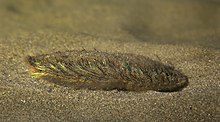Aphrodita aculeata
| Aphrodita aculeata | |
|---|---|
 |
|
| Aphrodita aculeata | |
| Scientific classification | |
| Kingdom: | Animalia |
| Phylum: | Annelida |
| Class: | Polychaeta |
| Order: | Phyllodocida |
| Suborder: | Aphroditoidea |
| Family: | Aphroditidae |
| Genus: | Aphrodita |
| Species: | A. aculeata |
| Binomial name | |
|
Aphrodita aculeata Linnaeus, 1758 |
|
Aphrodita aculeata, the sea mouse, is a marine polychaete worm found in the North Atlantic, the North Sea, the Baltic Sea and the Mediterranean. The sea mouse normally lies buried head-first in the sand. It has been found at depths of over 3,000 metres (9,800 ft).
The name of the genus is taken from Aphrodite, the Ancient Greek goddess of love. This is because, when viewed ventrally, the animal resembles a human female's genitalia. The English name may either have a similar meaning, or may derive from the supposed resemblance to a bedraggled mouse when washed up on shore. The specific name aculeata is the Latin for spiny.
The body of the sea mouse is covered in a dense mat of (hairlike structures). Adults generally fall within a size range of 10 to 20 centimetres (3.9 to 7.9 in).
The spines, or setae, on the scaled back of the sea mouse are one of its unique features. Normally, these have a deep red sheen, warning off predators, but when the light shines on them perpendicularly, they flush green and blue, a "remarkable example of photonic engineering by a living organism". This structural coloration is a defense mechanism, giving a warning signal to potential predators. The effect is produced by many hexagonal cylinders within the spines, which "perform much more efficiently than man-made optical fibres".
The sea mouse is an active predator feeding primarily on small crabs, hermit crabs and other polychaete worms including Pectinaria and Lumbriconereis. It has been observed consuming other polychaete worms over three times its own body length. Feeding activity takes place at night, with the animal partially buried in sand.
...
Wikipedia
